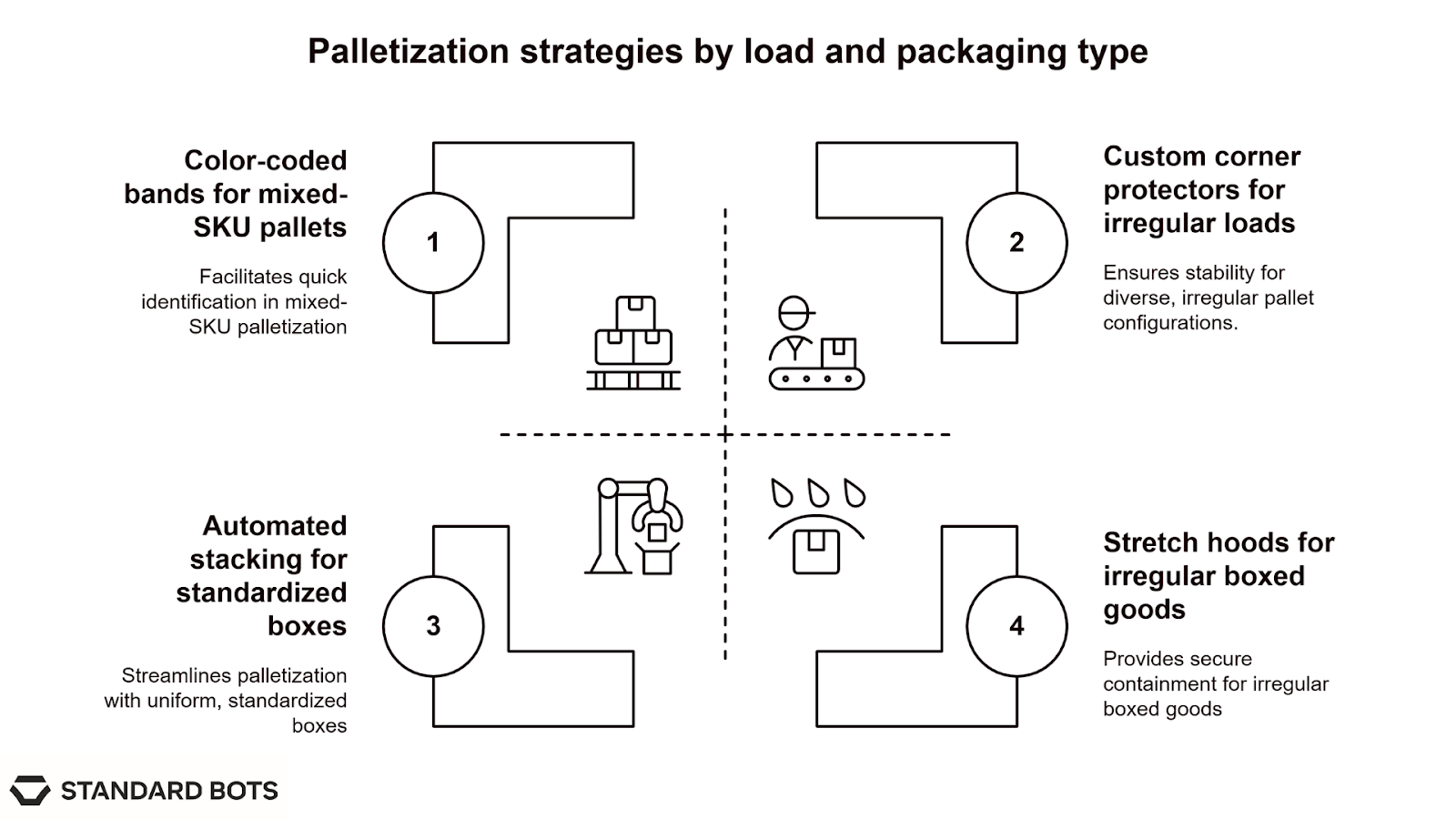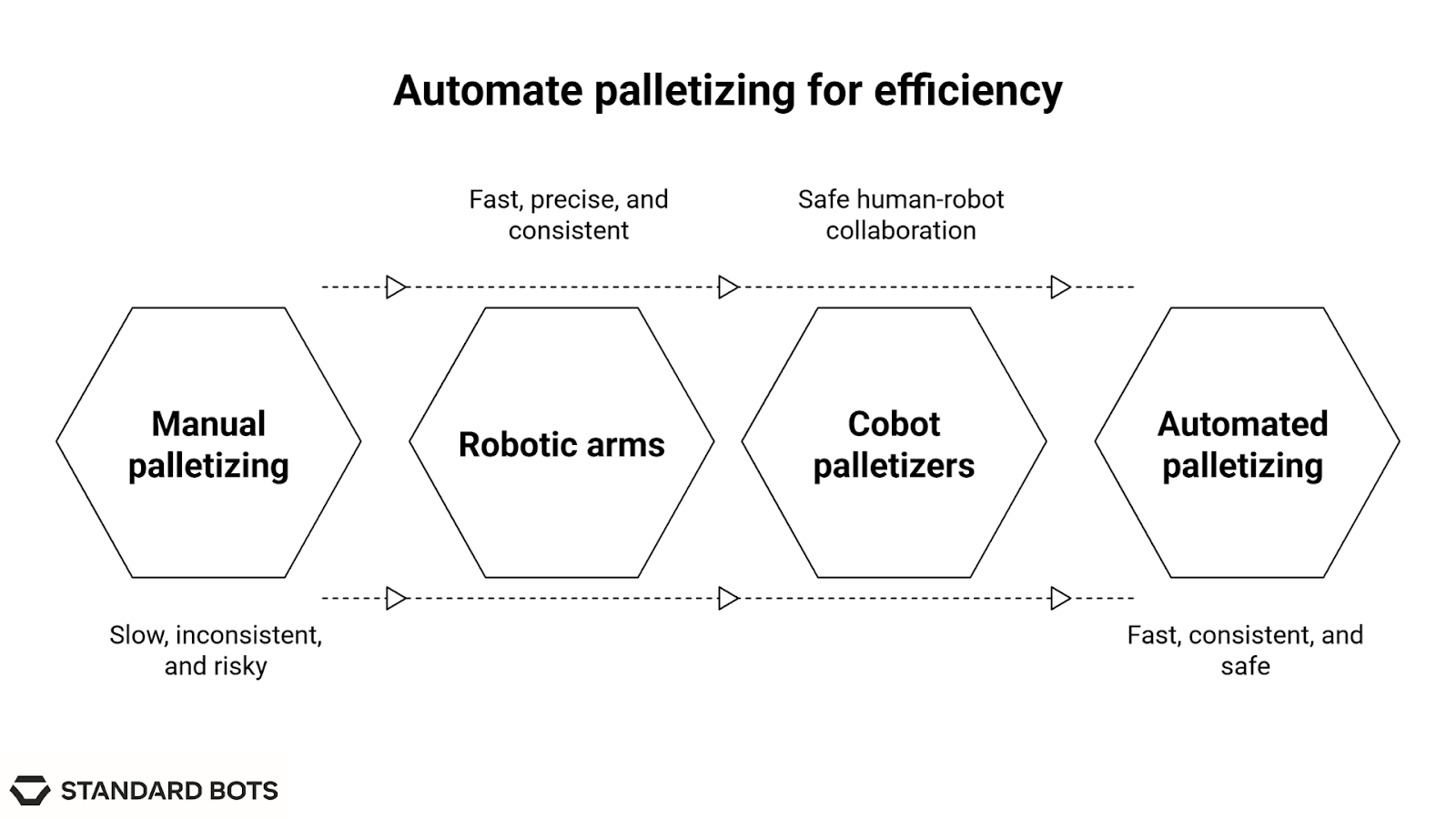Palletized goods are products stacked and secured on pallets so they can travel through warehouses, trucks, and ships with ease. This process, known as palletizing, is a global standard for moving goods faster, reducing damage, and squeezing more value out of every shipment.
From neatly wrapped stacks of food cartons to pallets loaded with electronics, most high‑volume shipments you see today are palletized for one reason: it works.
What is palletizing, and why is it used?
Palletizing is the art (and science) of stacking goods onto a pallet, usually made of wood or plastic, so they’re easy to move, store, and ship. Think of it as turning dozens of loose boxes, bags, or containers into one neat, stable “unit” that a forklift can whisk away in seconds.
Once stacked, the load is usually wrapped in stretch film or strapped down so nothing shifts during transport. The real value goes beyond just stacking: palletizing speeds up handling, keeps products safer in transit, and makes the most of every inch of warehouse or truck space.
Today, many companies are replacing the heavy lifting with robotic palletizers that use vision systems and smart stacking patterns to do the job faster and more precisely than humans ever could. Whether it’s for a local delivery or an overseas shipment, palletizing keeps goods moving smoothly from point A to point B.
Benefits of palletizing goods
Palletizing brings more than just order to a warehouse. It fundamentally changes how materials move through the supply chain.
- Higher throughput in material handling: When goods are palletized, each move shifts an entire unit instead of a single box. This increases how much product can be handled per hour, which is crucial for fast-paced environments like e-commerce fulfillment or large distribution hubs.
- Reduced risk of workplace injuries: Manual handling of individual items, especially heavy or bulky ones, can lead to strain, fatigue, and long-term injuries. Palletizing reduces the number of lifts and movements, and in automated setups, further reduces human contact with repetitive or high-risk tasks.
- Improved freight stability during transport: Whether you’re shipping by truck, rail, or sea, stacked and wrapped palletized materials hold their shape better than loose cartons. This prevents internal shifting, leaning, or collapsing that can damage goods mid-shipment and lead to costly returns or disputes.
- Better compatibility with automated systems: Most warehouse automation systems, like conveyors, stretch wrappers, AS/RS, or robotic pickers, are built to handle uniform pallet loads. Having pre-structured units eliminates the need for extra sorting or scanning steps, saving time and reducing processing errors.
- Organized inventory control and tracking: With palletized items, barcodes or RFID tags can be scanned at the pallet level instead of the individual SKU level. This simplifies inbound and outbound inventory tracking and allows for faster stock reconciliation and fewer pick errors.
- Optimized truck and container loading: Palletized products can be pre-planned to fit trailer or container dimensions using stacking software or robotic pattern generation. This reduces unused space, limits overhang, and ensures maximum utilization of available capacity.
- Lower likelihood of cross-contamination or product mixing: Especially in food, pharma, or chemical sectors, palletizing provides containment. Palletized units act as physical boundaries between different product types, lowering the chance of cross-contamination in mixed-load trucks or shared storage areas.
Whether you’re shipping across town or the ocean, palletizing keeps freight secure, operations smooth, and your bottom line healthier.
Real-world examples of palletized items
Palletizing isn’t one-size-fits-all. The approach varies by product, packaging type, fragility, and shipping method.
Here’s how different industries use palletization in real-world workflows:
1. Food and beverage products
Think bottled water, flour sacks, cereal boxes, or frozen meals rolling straight off a production line onto pallets. Companies like Coca-Cola use automated palletizing systems to handle millions of beverage cases daily, with stacks wrapped tightly to protect freshness, prevent leaks, and stop any mid‑shipment wobble.
In chilled or frozen storage, ventilated pallets or insulated wraps help maintain the cold chain from plant to store. For this reason, companies follow specific pallet stacking patterns based on load type, carton strength, and shipping conditions.
2. Electronics and consumer goods
Laptops, gaming consoles, and smart TVs demand extra care. They're cushioned with foam, wrapped to block moisture, and often strapped with corner protectors. Apple's distribution centers use precision palletizing for iPhones and MacBooks, with loads that are smaller but far more secure, sometimes even sealed in tamper‑proof film for long‑haul shipping.
3. Automotive parts and industrial components
Brake rotors, engine blocks, and transmissions don’t arrive in pretty boxes. They’re palletized in rugged bins, steel cages, or open containers for quick access on the assembly line. Heavy‑duty strapping, corner guards, and separators keep mixed‑load pallets stable, even when parts vary wildly in size.
4. Pharmaceuticals and chemicals
In the pharmaceutical sector, palletization ensures compliance, sterility, and traceability. Vaccines, syringes, diagnostic kits, and over-the-counter meds are usually packed in temperature-controlled containers and palletized for distribution to clinics or wholesalers.
For bulk chemicals, especially hazardous or sensitive materials, UN-certified drums or IBCs (Intermediate Bulk Containers) are palletized using containment trays and spill-proof liners. These are often strapped to pallets and loaded using custom brackets or cradle systems to prevent rolling or tipping.
5. Retail and e-commerce distribution
Big‑box retailers and online fulfillment centers build pallets backwards, from the shelf or delivery layout in mind. Heavy goods go on the bottom, lighter items on top, with divider sheets to separate SKUs. Some facilities even use cobots to stack in real time based on shipping priority.
In many modern warehouses, cobots or semi-automated palletizers stack items in real time based on inventory management software and outbound shipping priority.
How shipping type affects palletizing
- LTL (Less-than-truckload) shipping favors well-wrapped, compact pallets that can fit alongside other shipments without shifting. Carriers often reject or surcharge loose freight due to damage risks, so properly palletized goods are essential for reliability and cost control.
- FTL (Full truckload) shipments allow for greater control over pallet size, stacking patterns, and weight distribution. Businesses shipping bulk quantities use standardized pallets and software to calculate best-fit arrangements, reducing dead space in trailers and minimizing the number of trips required.
Types of palletized materials and configurations
Palletizing is about adapting to the specific properties of what you’re shipping. The shape, weight, fragility, and packaging type of a product all influence how it should be palletized.

Standardized vs. irregular loads
Standardized loads consist of products that are uniform in size, shape, and weight, such as sealed cartons of detergent, snack boxes, or tissue packs. These loads are easy to palletize using consistent patterns like columns or interlocking stacks. Facilities often automate their stacking for these items using fixed programming, as no variation exists between units.
Irregular loads, on the other hand, include items like oscillating fans, boxed furniture with uneven dimensions, or industrial parts with exposed handles or cables. These are more difficult to align and balance. Palletizing them safely may require the use of custom corner protectors, void fillers, or stretch hoods to secure gaps and prevent instability.
When palletizing in shipping high-value items, facilities may also reinforce pallets with wood blocks or anti-slip mats to absorb shock during transport. This is especially important for air or ocean freight, where vibration and handling conditions can be extreme.
Boxed vs. bagged vs. drum-shaped goods
Palletization methods differ sharply based on packaging type. Here’s how facilities handle different physical formats:
- Boxed goods: These are the most common palletized items, particularly in retail and CPG industries. Rigid boxes provide structural support and make stacking straightforward. They’re often shrink-wrapped tightly and can be double-stacked on trucks if the weight allows. Barcode labels are usually applied on two adjacent sides for quick scanning.
- Bagged products: Products like flour, sugar, cement, or pet food are palletized in heavy-duty plastic or woven bags. Because bags are flexible, they can bulge or deform during stacking. To counter this, interlocking or “brick-style” patterns are used to increase stability. Pallets may include slip sheets or anti-skid layers to prevent sliding, especially when stacking multiple tiers.
- Drum-shaped containers: Industrial liquids, chemicals, oils, or food-grade ingredients are often packaged in drums or barrels. These are typically placed upright on pallets with special cradles, chocks, or containment rings to prevent rolling. Drum pallets must be exceptionally stable because tipping one could cause severe damage or contamination.
Mixed-SKU palletization
Mixed-SKU palletization refers to stacking multiple product types on a single pallet. This is common in distribution centers, 3PLs, and e-commerce operations. Unlike standardized loads, mixed pallets introduce variation in size, weight, and destination, which adds complexity.
Operators must ensure heavy items go on the bottom, fragile goods on top, and that overall height doesn’t exceed shipping limits. Layer dividers, tier sheets, and labeling are used to keep products separated and traceable. Some warehouses also use color-coded bands or visual indicators to help teams quickly identify what goes where.
Manual palletizing of mixed SKUs can be slow, error-prone, and physically demanding. Many facilities are now investing in palletizing robots that dynamically adjust to incoming products using cameras and AI-based stacking logic.
If your facility handles fast-changing inventory, learn how a palletizing robot can adapt to new configurations in real time, improving both speed and load quality.
Manual vs automated palletizing

Manual palletizing
In a manual setup, workers physically lift and place each item onto a pallet. They follow visual guides, stacking patterns, or custom instructions to maintain balance and ensure safe transport. For smaller operations, manual palletizing is often the only option. It's low-cost, requires no special equipment, and works well for low-volume or varied loads.
However, manual palletizing is labor-intensive and prone to human error. Fatigue from repetitive motion can lead to misaligned stacks, inconsistent load stability, and even workplace injuries. This is especially risky when palletizing heavier products like drums or large boxed items.
As demand grows, the limitations become clearer:
- Slower throughput per shift
- Inconsistent stack quality between workers
- Higher risk of strain injuries or compliance violations
- Bottlenecks in fast-moving distribution environments
Facilities still relying on manual stacking often explore ergonomic aids or semi-automation, like lift-assist devices or turntables, to ease the physical burden without fully switching to robotics.
Automated palletizing
Automated palletizing uses programmable machines, typically robotic arms or gantry systems, to handle repetitive stacking tasks with speed and precision. These systems are ideal for facilities with high volumes, standardized packaging, or limited labor availability.
Modern palletizing robots don’t just follow rigid pre-set routines. Many use sensors, barcode scanners, or vision systems to adapt stacking patterns on the fly. This makes them suitable for both simple and mixed-SKU loads, even when packaging varies slightly.
One advantage of robotic systems is consistency. A robot will palletize every box with the same placement accuracy, eliminating the small errors that lead to leaning stacks or collapsed loads. Over time, this improves freight safety and reduces damage claims.
For facilities with limited floor space or evolving workflows, cobot palletizers are a growing solution. These collaborative robots are designed to work safely alongside humans without cages or fencing.
Paired with a compatible cobot gripper, they can handle bags, boxes, or even irregular shapes with minimal adjustment.
Final thoughts: Why palletization matters more than you think
Palletizing is the backbone of modern logistics that keeps supply chains moving fast and freight arriving intact. Speed beats manual every time because palletized goods move through warehouses with one forklift move handling entire units instead of dozens of individual boxes.
Plus, damage prevention saves serious money since properly stacked pallets stay stable during transport, meaning fewer damaged goods and insurance claims. Labor costs drop significantly whether you're using manual methods or robotic palletizers, as organizing products into pallet loads reduces physical strain and handling time.
In 2025, palletizing is table stakes for any operation moving products regularly. Skip it, and you're choosing to work harder for less profit.
Take the strain out of palletizing with Standard Bots
Manual stacking slows you down and wears your team out. Looking to upgrade your automation game?
Standard Bots’ RO1 is the perfect six-axis cobot addition to any palletizing setup, delivering unbeatable precision and flexibility.
- Affordable and adaptable: RO1 costs $37K (list). Get high-precision automation at half the cost of traditional robots.
- Precision and power: With a repeatability of ±0.025 mm and an 18 kg payload, RO1 handles even the most demanding CNC jobs.
- AI-driven simplicity: Equipped with AI capabilities on par with GPT-4, RO1 integrates seamlessly with CNC systems for advanced automation.
- Safety-first design: Machine vision and collision detection mean RO1 works safely alongside human operators.
Schedule your on-site demo with our engineers today and see how RO1 can bring AI-powered greatness to your shop floor.
FAQs
1. What is the difference between floor loading and palletizing?
The main difference between floor loading and palletizing is that in floor loading, the items are placed directly on the truck floor without pallets, which often maximizes space. Palletizing, on the other hand, uses platforms to stack and stabilize goods, making handling faster and safer, especially with forklifts.
2. What are the standard pallet sizes and weight limits?
The standard pallet size is 48” x 40” in the US. Most standard pallets hold up to 2,000 to 2,800 pounds, but that varies based on material and load configuration.
3. How much does palletization typically cost per pallet?
Palletization costs per pallet can range from $35 to $75, but the exact cost varies depending on several factors. These factors include the type of pallet, the carrier, and whether the shipper or carrier provides the pallets. Additional costs like pallet rental or handling fees can also influence the total cost.
4. Can hazardous materials be palletized safely?
Yes, hazardous items can be palletized using drums, secure banding, and proper labeling. Regulatory-compliant materials like spill-proof pallets and containment trays are often required for safety.
5. How can I improve manual palletizing efficiency without automation?
To improve manual palletizing efficiency without automation, use ergonomic tools like lift-assist arms, follow proper stacking patterns, and optimize packaging sizes. Consistent layouts and fewer mixed SKUs also reduce time and effort during manual palletizing.
6. What does “non-palletized” mean in shipping documents?
Non-palletized in shipping refers to loose items not secured on a pallet. These are more labor-intensive to move and may be charged higher freight rates due to handling risks.
7. Does palletizing affect my carrier’s freight class or shipping rate?
Yes, palletizing affects your carrier’s freight class or shipping rate as palletized goods are often classified more favorably by carriers because they’re easier to stack and handle.
Join thousands of creators
receiving our weekly articles.












